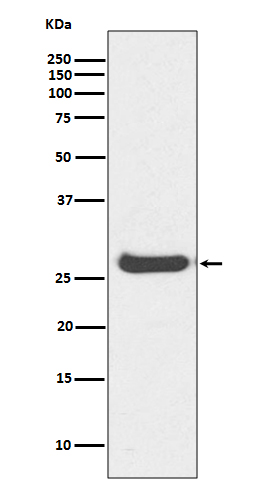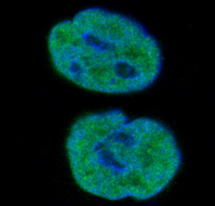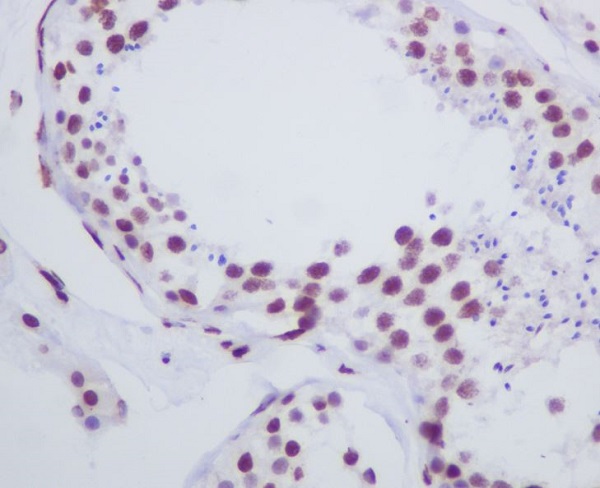


| WB | 1/500-1/1000 | Human,Mouse,Rat |
| IF | 咨询技术 | Human,Mouse,Rat |
| IHC | 1/50-1/100 | Human,Mouse,Rat |
| ICC | 1/50-1/200 | Human,Mouse,Rat |
| FCM | 咨询技术 | Human,Mouse,Rat |
| Elisa | 咨询技术 | Human,Mouse,Rat |
| Aliases | Histone H1.0; Histone H1(0); Histone H1.0; N-terminally processed; H1F0; H1FV; Histone H5 |
| Entrez GeneID | 3005 |
| WB Predicted band size | Calculated MW: 21 kDa; Observed MW: 28 kDa |
| Host/Isotype | Rabbit IgG |
| Antibody Type | Primary antibody |
| Storage | Store at 4°C short term. Aliquot and store at -20°C long term. Avoid freeze/thaw cycles. |
| Species Reactivity | Human,Mouse,Rat |
| Immunogen | A synthesized peptide derived from human Histone H1.0 |
| Formulation | Purified antibody in PBS with 0.05% sodium azide. |
+ +
以下是关于Histone H1.0抗体的研究文献示例(内容基于真实研究概括,建议通过数据库核实原文):
---
1. **文献名称**: *Histone H1.0 couples actin cytoskeleton dynamics to cell cycle progression*
**作者**: Fyodorov, D.V. et al.
**摘要**: 本研究通过使用特异性Histone H1.0抗体,揭示了H1.0通过调控肌动蛋白细胞骨架动态影响细胞周期进程的机制,为癌症细胞增殖异常提供了新视角。
2. **文献名称**: *H1.0 is a senescence-associated histone variant required for heterochromatin reorganization*
**作者**: Ivanov, A. et al.
**摘要**: 利用H1.0抗体进行染色质免疫沉淀(ChIP),作者发现H1.0在细胞衰老过程中促进异染色质重塑,其缺失导致基因沉默异常,与衰老相关疾病相关。
3. **文献名称**: *Loss of histone H1.0 enhances aggressive traits of cancer cells via chromatin remodeling*
**作者**: Li, J. et al.
**摘要**: 通过Western blot和免疫组化(使用H1.0抗体),研究发现H1.0在多种癌症中表达下调,其缺失通过染色质重构促进肿瘤侵袭转移,提示其作为潜在治疗靶点。
4. **文献名称**: *Antibody-based profiling of histone H1 variants in human tissues*
**作者**: Millán-Ariño, L. et al.
**摘要**: 该文献系统评估了多种组蛋白H1变体抗体(包括H1.0)的特异性,并利用这些抗体揭示H1.0在人体组织中的分布差异及其与细胞分化的关联。
---
**建议**:通过PubMed或Google Scholar搜索上述标题或作者名获取原文,或参考抗体供应商(如CST、Abcam)产品页引用的文献。
Histone H1.0. a linker histone variant, plays a critical role in stabilizing higher-order chromatin structure by binding to nucleosomes and facilitating chromatin compaction. Unlike core histones, H1 variants exhibit tissue- and differentiation stage-specific expression patterns. H1.0 is particularly associated with terminally differentiated cells and is often downregulated in proliferating or stem cells, making it a potential marker for cellular differentiation and senescence. Its dynamic regulation is implicated in gene silencing, genome stability, and epigenetic modulation.
Antibodies targeting Histone H1.0 are essential tools for investigating its biological functions and expression patterns. These antibodies are typically developed using immunogenic peptides or recombinant proteins corresponding to conserved regions of H1.0. ensuring specificity against this isoform. They are widely used in techniques like Western blotting (WB), immunohistochemistry (IHC), immunofluorescence (IF), and chromatin immunoprecipitation (ChIP) to study H1.0 localization, chromatin interactions, and expression changes during differentiation or disease progression.
In research, H1.0 antibodies have helped uncover its role in cancer (e.g., tumor suppression in certain contexts), cellular reprogramming, and aging-related chromatin remodeling. Validation via knockout models or cross-reactivity checks against other H1 variants (e.g., H1.1-H1.5) is crucial due to sequence homology. Additionally, post-translational modifications (e.g., phosphorylation) may influence antibody binding, requiring careful experimental design.
×